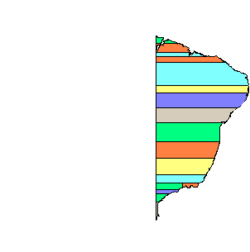Conquista do Pará
Conquista do Pará Império do Amazonas | |
|---|---|
 | |
| Capital | Salvador |
| Common languages | Portuguese, Indigenous languages, African languages, Nheengatu |
| Religion | Catholicism |
| Government | Monarchy |
| King | |
| Today part of | Brazil |
Conquista do Pará (region initially called pa'ra, from Tupi-Guarani: "river-sea"), also called the Império das Amazonas (in English: Amazonas Empire), now the Brazilian state of Pará, was an indigenous territory transformed into Portuguese colonial territory in 1615 by the military man and nobleman Alexandre de Moura, at the beginning of the colonization of the Amazon and conquest of the Amazon River.[1] It was located in the then Captaincy of Maranhão (1534-1621).[2][3]
The Captaincy of Maranhão had 75 leagues of coastline, extending from the Bay of All Saints to the mouth of the da Cruz River, covering the northeastern area of the current state of Maranhão, the eastern region of the Conquista do Pará (where Belém is today), and the island of Marajó.[4]
In 1621, the Conquista do Pará was transformed into the Captaincy of Grão Pará and the State of Maranhão,[1] consolidating Portuguese rule in the Amazon.[1][5][6]
History
[edit]In 1534, the Captaincy of Maranhão was created along with 13 other hereditary captaincies,[7] in the colonial period of Portuguese America, combining feudal and capitalist elements; a system that had been used successfully in the development of the islands of Madeira and Azores.[8]
In 1572, the Portuguese Crown, still perceiving flaws in colonial administration, divided Portuguese America into two general governments (from 1572 to 1577):[9] Government of the North (with Salvador as capital) which had administrative dominion over the future Conquista do Pará (1615); and the Government of the South, with its capital in Rio de Janeiro.[10][11]
In 1615, the military man and nobleman Alexandre de Moura began the protection and colonization of the Amazon region, conquering the mouth of the Amazon River and transforming the indigenous region in the far north called Mairi[1] (home to the Tupinambá and Pacajá Indians under the command of cacique Guaimiaba),[9][5][6] into the Portuguese colonial territory Conquista do Pará or Império das Amazonas ("Amazonas Empire") (1615–1621),[1] located in the then Captaincy of Maranhão (1534–1621).[2][3]
In 1616, in an attempt to secure dominance in eastern Amazon and protect the region from the Dutch and British in search of spices (the drogas do sertão),[1][12][13][5][6] the Portuguese, at the behest of the King of the Iberian Union/Philippine Dynasty, Manuel I, held the military expedition Feliz Lusitânia. It was commanded by Captain Francisco Caldeira Castelo Branco and founded the Conquista do Pará near the Piry creek on January 12, 1616,[14][15][9][16] starting the colonial settlement named after the military expedition (present-day city of Belém).[5][17][18]
In 1621, Conquista do Pará was transformed into the Captaincy of Grão Pará and the State of Maranhão (1621–1775).[1]

References
[edit]- ^ a b c d e f g "Capitania do Grão-Pará". Atlas Digital da América Lusa. Laboratório de História Social (LHS) da Universidade de Brasília (UNB) (in Portuguese). Archived from the original on 3 November 2022. Retrieved 27 December 2017.
- ^ a b "PROJETO PEDAGÓGICO INSTITUCIONAL 2019 - 2023" (PDF). Faculdade Metropolitana do Pará - FAMETRO (in Portuguese). 2019. Archived from the original (PDF) on 26 January 2022. Retrieved 26 January 2022.
- ^ a b de Lacerda, Joaquim Maria (1911). Pequena História do Brasil (in Portuguese). Bertrand.
- ^ Koogan; Houaiss (1993). Enciclopédia e Dicionário Ilustrado (in Portuguese). Edições Delta. p. 2044.
- ^ a b c d "Brasil, Pará, Belém, História". Instituto Brasileiro de Geografia e Estatística (in Portuguese). 2012. Retrieved 8 March 2018.
- ^ a b c Pereira, Carlos Simões (28 October 2020). "Das origens da Belém seiscentista e sua herança Tupinambá". Revista Científica Multidisciplinar Núcleo do Conhecimento. 10: 146–160. doi:10.32749/nucleodoconhecimento.com.br/historia/heranca-tupinamba. ISSN 2448-0959. S2CID 228931228.
- ^ "O Sistema de Capitanias Hereditárias". Portal MultiRio (in Portuguese). Retrieved 18 January 2017.
- ^ Boxer, Charles, R. (2003). O Império Marítimo Português (in Portuguese). Companhia das Letras. p. 101.
{{cite book}}: CS1 maint: multiple names: authors list (link) - ^ a b c Capitais brasileiras : dados históricos, demográficos, culturais e midiáticos. Celsi Brönstrup Silvestrin, Gisele Noll, Nilda Jacks (1a edição ed.). Curitiba, PR. 2016. ISBN 978-85-473-0291-7. OCLC 1003295058.
{{cite book}}: CS1 maint: location missing publisher (link) CS1 maint: others (link) - ^ "Governo-Geral: resumo, contexto, características". Mundo Educação (in Brazilian Portuguese). Retrieved 27 January 2022.
- ^ "Reficio". reficio.cloud (in Portuguese). Retrieved 22 February 2022.
- ^ Pacievitch, Thais. "História do Pará - História". InfoEscola (in Brazilian Portuguese). Retrieved 11 August 2013.
- ^ Itamaraty Ministério das Relações exteriores (1997). "O Estado do Pará" (PDF). Revista Textos do Brasil (1): 2.
- ^ Coimbra, Oswaldo; Neto, Alfredo Jorge Hesse Garcia (2008). "Cidade velha, cidade viva". Universidade Federal do Pará (UFPA) (in Portuguese).
- ^ "Açaí, jambu e a Amazônia: 10 curiosidades sobre o Pará". bol.uol.com.br (in Brazilian Portuguese). Retrieved 7 March 2018.
- ^ "I DECLARAÇÃO AOS POVOS SOBRE O TERRITÓRIO MURUCUTU TUPINAMBÁ". Idade Mídi@ (in Brazilian Portuguese). 2022-01-07. Retrieved 7 January 2022.
- ^ Tavares, Maria Goretti da Costa (2008). "A Formação Territorial do Espaço Paraense". Revista ACTA Geográfica nº 3 - Ano II. Universidade Federal do Pará (UFPa). doi:10.5654/actageo2008.0103.0005. ISSN 1980-5772.
- ^ PA, Do G1 (2016-01-09). "Veja como foi a fundação de Belém em 1616 e conheça sua história". Belém 400 anos (in Brazilian Portuguese). Retrieved 4 May 2016.
{{cite web}}: CS1 maint: numeric names: authors list (link)
|
Preceded by: Pa'ra Indian Region 1621 |
Conquista do Pará Império das Amazonas 1615 – 1621 |
Succeeded by: 1621–1822 |

